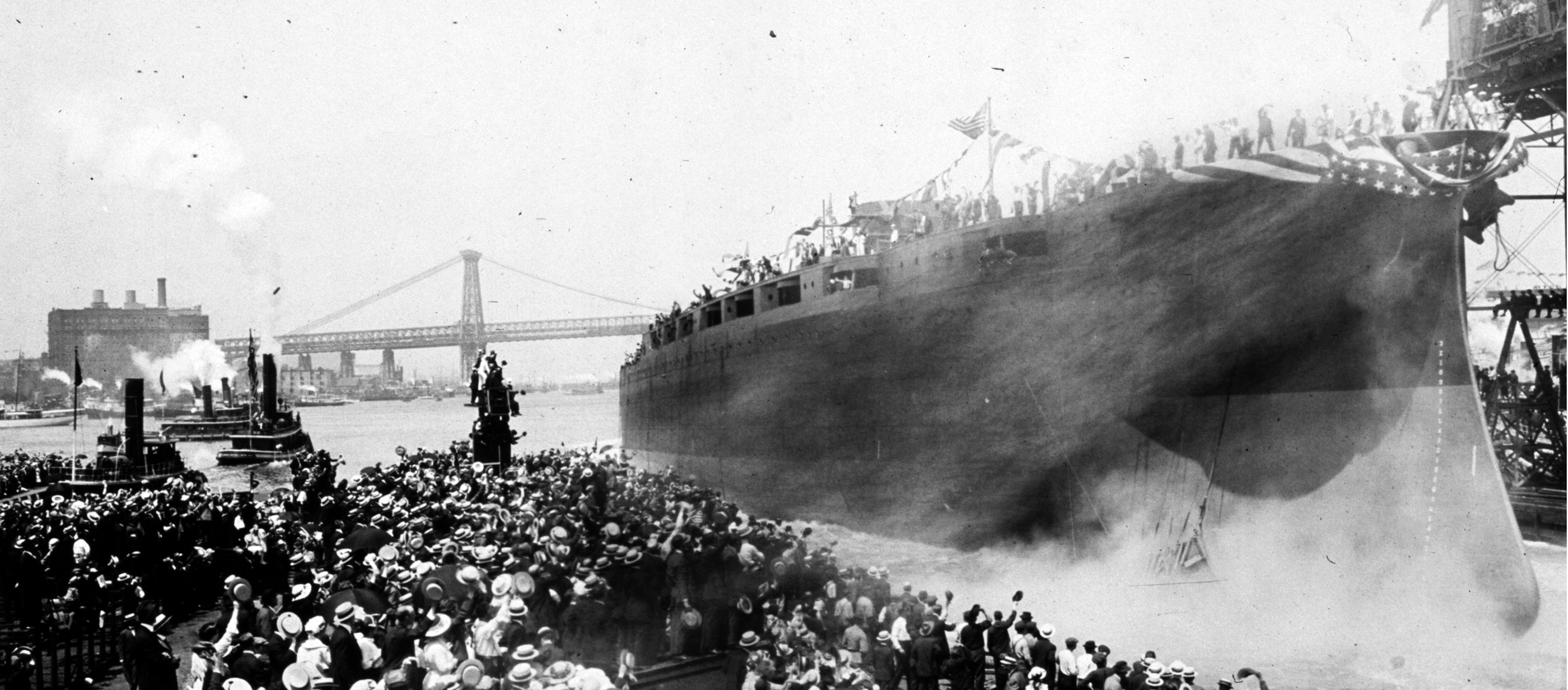Tomorrow we take to the mighty sea.
—Horace, 23 BCLove of the Sea
Joseph Conrad’s complicated relationship with the briny deep.
“Ships!” exclaimed an elderly seaman in clean shore togs. “Ships!”—and his keen glance, turning away from my face, ran along the vista of magnificent figureheads that in the late seventies used to overhang in a serried rank the muddy pavement by the side of the new south dock—“ships are all right; it’s the men in ’em…”
Fifty hulls, at least, molded on lines of beauty and speed—hulls of wood, of iron, expressing in their forms the highest achievement of modern shipbuilding—lay moored all in a row, stem to quay, as if assembled there for an exhibition not of a great industry but of a great art. Their colors were gray, black, dark green, with a narrow strip of yellow molding defining their sheer, or with a row of painted ports decking in warlike decoration their robust flanks of cargo carriers that would know no triumph but of speed in carrying a burden, no glory other than of a long service, no victory but that of an endless, obscure contest with the sea. The great empty hulls with swept holds, just out of dry dock, with their paint glistening freshly, sat high sided with ponderous dignity alongside the wooden jetties, looking more like unmovable buildings than things meant to go afloat; others, half loaded, far on the way to recover the true sea physiognomy of a ship brought down to her load line, looked more accessible. Their less steeply slanting gangways seemed to invite the strolling sailors in search of a berth to walk on board and try “for a chance” with the chief mate, the guardian of a ship’s efficiency. As if anxious to remain unperceived among their overtopping sisters, two or three “finished” ships floated low, with an air of straining at the leash of their level head-fasts, exposing to view their cleared decks and covered hatches, prepared to drop stern first out of the laboring ranks, displaying the true comeliness of form which only her proper sea trim gives to a ship. And for a good quarter of a mile, from the dockyard gate to the farthest corner, where the old housed-in hulk, the President (drill ship then of the naval reserve), used to lie with her frigate side rubbing against the stone of the quay, above all these hulls, ready and unready, 150 lofty masts, more or less, held out the web of their rigging like an immense net in whose close mesh, black against the sky, the heavy yards seemed to be entangled and suspended.
It was a sight. The humblest craft that floats makes its appeal to a seaman by the faithfulness of her life, and this was the place where one beheld the aristocracy of ships. It was a noble gathering of the fairest and the swiftest, each bearing at the bow the carved emblem of her name, as in a gallery of plaster casts, figures of women with mural crowns, women with flowing robes, with gold fillets on their hair or blue scarves round their waists, stretching out rounded arms as if to point the way; heads of men helmeted or bare; full lengths of warriors, of kings, of statesmen, of lords and princesses, all white from top to toe; with here and there a dusky, turbaned figure, bedizened in many colors, of some Eastern sultan or hero—all inclined forward under the slant of mighty bowsprits as if eager to begin another run of eleven thousand miles in their leaning attitudes. These were the fine figureheads of the finest ships afloat. But why, unless for the love of the life those effigies shared with us in their wandering impassivity, should one try to reproduce in words an impression of whose fidelity there can be no critic and no judge, since such an exhibition of the art of shipbuilding and the art of figurehead carving as was seen from year end to year end in the open-air gallery of the new south dock no man’s eye shall behold again? All that patient, pale company of queens and princesses, of kings and warriors, of allegorical women, of heroines and statesmen and heathen gods, crowned, helmeted, bareheaded, has run for good off the sea, stretching to the last above the tumbling foam their fair, rounded arms, holding out their spears, swords, shields, tridents in the same unwearied, striving-forward pose. And nothing remains but lingering perhaps in the memory of a few men, the sound of their names, vanished a long time ago from the first page of the great London dailies; from big posters in railway stations and the doors of shipping offices; from the minds of sailors, dock masters, pilots, and tug men; from the hail of gruff voices and the flutter of signal flags exchanged between ships closing upon each other and drawing apart in the open immensity of the sea.

Launching the USS Arizona, Brooklyn Navy Yard, 1915. U.S. National Archives and Records Administration, College Park, Maryland.
For all that has been said of the love that certain natures (on shore) have professed to feel for it, for all the celebrations it had been the object of in prose and song, the sea has never been friendly to man. At most it has been the accomplice of human restlessness, and playing the part of dangerous abettor of worldwide ambitions. Faithful to no race after the manner of the kindly earth, receiving no impress from valor and toil and self-sacrifice, recognizing no finality of dominion, the sea has never adopted the cause of its masters like those lands where the victorious nations of mankind have taken root, rocking their cradles and setting up their gravestones. He—man or people—who, putting his trust in the friendship of the sea, neglects the strength and cunning of his right hand, is a fool! As if it were too great, too mighty for common virtues, the ocean has no compassion, no faith, no law, no memory. Its fickleness is to be held true to men’s purposes only by an undaunted resolution, and by a sleepless, armed, jealous vigilance, in which, perhaps, there has always been more hate than love. Odi et amo may well be the confession of those who consciously or blindly have surrendered their existence to the fascination of the sea. All the tempestuous passions of mankind’s young days, the love of loot and the love of glory, the love of adventure and the love of danger, with the great love of the unknown and vast dreams of dominion and power, have passed like images reflected from a mirror, leaving no record upon the mysterious face of the sea. Impenetrable and heartless, the sea has given nothing of itself to the suitors for its precarious favors. Unlike the earth, it cannot be subjugated at any cost of patience and toil. For all its fascination that has lured so many to a violent death, its immensity has never been loved as the mountains, the plains, the desert itself, have been loved. Indeed, I suspect that, leaving aside the protestations and tributes of writers who, one is safe in saying, care for little else in the world than the rhythm of their lines and the cadence of their phrase, the love of the sea, to which some men and nations confess so readily, is a complex sentiment wherein pride enters for much, necessity for not a little, and the love of ships—the untiring servants of our hopes and our self-esteem—for the best and most genuine part. For the hundreds who have reviled the sea, beginning with Shakespeare in the line, “More fell than hunger, anguish, or the sea,” down to the last obscure sea dog of the “old model,” having but few words and still fewer thoughts, there could not be found, I believe, one sailor who has ever coupled a curse with the good or bad name of a ship. If ever his profanity, provoked by the hardships of the sea, went so far as to touch his ship, it would be lightly, as a hand may without sin be laid in the way of kindness on a woman.

Joseph Conrad
From “Initiation.” Leaving Cracow for Marseille at the age of sixteen in 1874, Conrad made his first sea voyages aboard steamers bound for the West Indies—at one time running guns—and docked in England for the first time in 1878, knowing only a few words of the country’s language. He served sixteen years in the British Merchant Navy, his experiences furnishing him with material for the works of fiction he published in English, among them, Heart of Darkness in 1899, Lord Jim in 1900, and Typhoon in 1902. The autobiographical essay “Initiation” was published in Conrad’s book The Mirror of the Sea in 1906.




